After learning witches are made of wood, peasants in Monty Python and the Holy Grail, are asked what, besides wood, floats. One peasants asks hopefully: “tiny rocks”? Well there are ways for rocks and other heavy cargo to float, and floating across the world’s oceans today are millions of tons of steel and aluminum forged and smelted in China.
By ship is by far the least expensive way for steel to travel from producers to consumers. Shipping costs from China to Californi a are lower than shipping by rail from steel mills in Pennsylvania, Ohio, and Indiana. So coastal Chinese steel and aluminum producers can have a significant cost advantage along America’s west coast, and can be competitive in markets in other coastal cities.
a are lower than shipping by rail from steel mills in Pennsylvania, Ohio, and Indiana. So coastal Chinese steel and aluminum producers can have a significant cost advantage along America’s west coast, and can be competitive in markets in other coastal cities.
High taxes (tariffs) on imported aluminum and steel can save companies and jobs in domestic steel and aluminum industries, but are costly and job-destroying for U.S. manufacturers who depend upon these raw materials for their production processes.
The November 8, 2016 Wall Street Journal article “U.S. Says Aluminum Exports From Chinese Firm Evaded Restrictions” reports:
U.S. officials said a Chinese aluminum magnate is sidestepping U.S. trade sanctions, the latest development in federal attempts to rein in a flood of cheap metal imports that have overwhelmed U.S. producers.
The reporters uses says “cheap metal imports” are “flooding” the U.S. Here though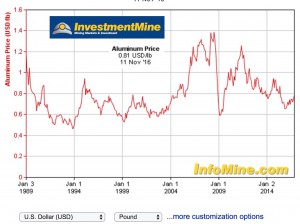 is an InvestmentMine chart showing 25 years of aluminum prices. Looks like aluminum prices have been going up and down over the years, with a surge in 2006-2008, followed a steep fall in prices with the financial crisis of 2008-2009, and prices surging after, then falling again.
is an InvestmentMine chart showing 25 years of aluminum prices. Looks like aluminum prices have been going up and down over the years, with a surge in 2006-2008, followed a steep fall in prices with the financial crisis of 2008-2009, and prices surging after, then falling again.
When aluminum prices are high, producers make huge profits and tend to invest some of those profits in expanding output. As new capacity boosts supply, prices are pushed down, leading aluminum companies to reduce production but also to complain to Congress and the Department of Commerce about “dumping” by foreign firms.
Two points to keep in mind about imports of aluminum, steel, copper and other metals. First, as key raw materials to U.S. manufacturing, lower metals prices help U.S. manufacturers stay competitive. With steel prices up 70% so far in 2016, U.S. manufacturers face higher costs and often raise prices, making their goods less attractive to consumers. Firms trying to absorb much higher raw materials costs have less margin for raising wages, capital investment, and dividends.
U.S. Steel’s campaign to exclude Chinese steel imports would make U.S. companies that manufacture products from steel less competitive, steel users told a federal agency. They also said domestic steelmakers either don’t want to make some of the steel they need or can’t make it as reliably as Chinese suppliers do.
It is not the case that steel (or aluminum) are monolithic products and few U.S. manufacturing firms want to purchase lumps of raw steel or aluminum. The article quotes various U.S. steel users who emphasize the benefits to them of access to specialized steel producers in China:
Michael Papera, who purchases steel for Allstate Can in Parsippany, N.J., told the agency that the steel his company buys from Baosteel of China “is by far superior to anything purchased domestically in the way of shape and performance.”
Baosteel is one of the Chinese producers targeted by U.S. Steel.
Neal Lux, president of Global Tubing, said the Dayton, Texas, company worked with an unnamed U.S. steelmaker to provide steel used to make tubing for the energy industry.
“The results were disastrous,” he wrote.
So it is interesting that with the media and think tank concern the Trump Administration might launch a damaging trade war with China, U.S. manufacturers are already suffering from ongoing trade disputes launched by U.S. steel and aluminum producers, and their associations, working through Department of Commerce Anti-Dumping (AD) and Countervailing Duties (CFD) operations:
The Antidumping and Countervailing Duty Operations Unit is responsible for
enforcing U.S. antidumping duty (AD) and countervailing duty (CVD) laws. AD/CVD Operations conducts investigations in response to petitions received by the Department from domestic industries and/or labor unions. AD/CVD Operations also conducts subsequent proceedings known as administrative reviews in which importers’ actual duty liability is assessed.
The Wall Street Journal reports on continued efforts to keep aluminum import costs high:
The Commerce Department in 2010 had punished China Zhongwang and other Chinese producers with tariffs as high as 374.15% after finding they were receiving illegal subsidies and dumping, or selling products in the U.S. below market prices.
Chinese firms receive subsidies from local, regional, and national governments in China. But so do many U.S. firms. General Motors and Chrysler were bankrupt in the financial crisis and bailed out by the U.S. government (along with various insurance and investment firms). U.S. aluminum production benefits from inexpensive electricity from federally-funded dams in the Pacific Northwest. State governments provide tens of millions in subsidies for new auto plants and other factories, plus spend millions on road and rail infrastructure to help these goods reach international markets.
Alcoa (Aluminum Company of America) is listed as #2 among the ten U.S. firms receiving federal subsidies (May 07, 2015):
You may not know Alcoa by name, but there’s probably at least one product with Alcoa aluminum in it somewhere in your home. As the world’s third largest producer of aluminum, Alcoa has an extensive history dating back to 1886 when it was first founded in Pittsburgh, Pennsylvania. The company has received $5.64 billion across 99 subsidies according to Find Good Jobs‘ report, which have helped the company go on to secure lucrative contracts for projects, like building jet engine parts.
As of the past few years, Alcoa has really been picking up steam. Production has increased at its numerous plants and stock prices have jumped as investors have taken notice. As the company continues to ramp things up, look for subsidy levels to remain high in coming years.
The federal government has spend billions on solar and wind power as well (though these subsidies, combined with renewable energy mandates, tend to raise energy prices and costs for U.S. firms and consumers). (This 2016 article disagrees, with study showing no statistical increase.)
Businesses and industries often turn to government both for subsidies for their operations and for trade restrictions hampering foreign competitors. Chinese firms lobby for subsidies and trade restrictions much as U.S. firms do.
Which firms receive the largest subsidies and the most effective/damaging trade restrictions, is a question for economists (and debaters) to research. But in all cases other manufacturing firms must deal with the challenge of higher prices and limited access to supplies needed for their operations. Firms in developed countries have integrated supply chains and Department of Commerce AD and CVD regulations throw wrenches in these supply chains.
The next Administration has the option reduce or remove disruptive and costly trade barriers, as well as to set up new ones.
Update: This November 14, 2016 Foreign Affairs article, “Will China Trump Trump? Antagonizing Beijing for Short-Term Gain,” provides useful overview of problems neo-mercantilist policies would cause with current US/China/Mexico supply chains:
Overall industrial output in the United States is at a historical high, while manufacturing employment is at a historical low. As it happened with agriculture more than a century ago, technological progress, which leads to productivity gains, is to be blamed for the dearth of blue-collar jobs in the United States. Globalization only reinforces the underlying dynamics. Moreover, in a world of global value chains, where production is sliced and diced across the world, several imports from China, such as auto parts, steel, semiconductors, and plastics, are actually intermediate goods or raw material for U.S. exporters, meaning that they contribute to the value of the final good.
Previous posts have reviewed arguments both for and against additional trade restrictions with China.

 disproportionately to the wealthy, while the costs have fallen on displaced workers, and governments have failed to ease their pain.
disproportionately to the wealthy, while the costs have fallen on displaced workers, and governments have failed to ease their pain.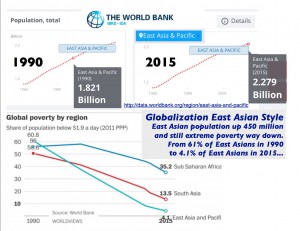
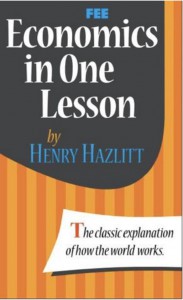 Henry Hazlitt’s Economics in One Lesson, long popular in high school debate classes, is
Henry Hazlitt’s Economics in One Lesson, long popular in high school debate classes, is 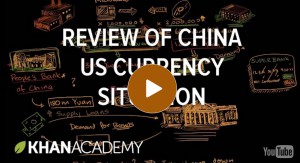 d Marginal Revolution University offer a series of video lectures.
d Marginal Revolution University offer a series of video lectures.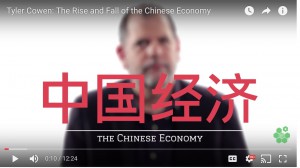 MRU’s Tyler Cowen has a separate recent video, The Rise and Fall of the Chinese Economy, here.
MRU’s Tyler Cowen has a separate recent video, The Rise and Fall of the Chinese Economy, here. 